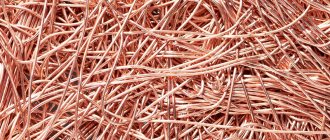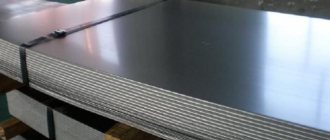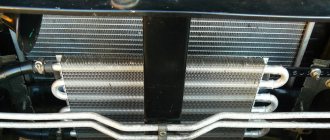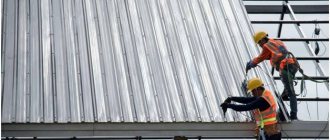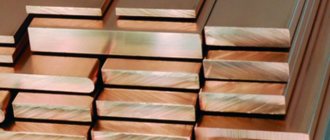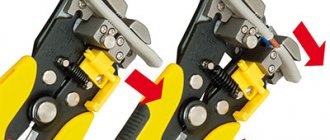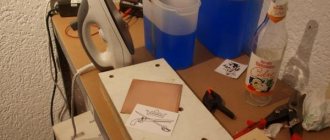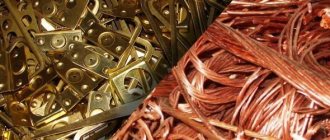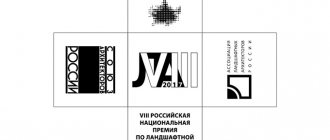Copper
Copper
(according to GOST 859-2001)
is produced
in the form of cathodes, ingots and semi-finished products
| Brand designation | Copper,%, not less | Copper+Silver,%, not less | Method of obtaining | Application area |
| M00b M0b M1b | 99,9 — — | — 99,97 99,95 | Remelting cathodes in a reducing or inert atmosphere or in a vacuum | Current conductors, high purity alloys, semi-finished products for the electronics industry |
| M00 M0 M1 | 99,96 — — | — 99,93 99,90 | Remelting cathodes | Current conductors, rolled products, high-quality bronze |
| M1r M1f M2r M3r | — — — — | 99,90 99,90 99,70 99,50 | Melting of copper cathode and scrap with phosphorus deoxidation | High-quality semi-finished products and copper-based alloys |
| M2 M3 | — — | 99,70 99,50 | Fire refining and smelting of copper waste and scrap | Rolled products, copper-based alloys of ordinary quality |
Notes:
- The melting point of copper
is 1083 °C. - GOST provides for other grades of copper.
The designation of copper grades M1 and M1p, intended for the electrical industry and subject to testing for electrical conductivity, additionally includes the letter “E”. - The yield strength
of deformed copper is 380 N/mm², annealed copper is 70 N/mm² - Electrical resistivity
- 0.0172 Ohm mm²/m
Round copper rods (according to GOST 1535-91 as amended in 2001)
The standard applies to drawn copper bars of round, square, hexagonal cross-section and pressed round bars.
- Diameters of pressed (hot-rolled) round bars, mm:
20, 22, 28, 30, 32; 35; 38; 40; 45; 50; 55; 60; 65; 70; 75; 80; 85; 90; 95; 100, 110, 120, 130, 140, 150. - Diameters of drawn rods, mm:
3; 3.5; 4; 4.5; 5; 5.5; 6; 7; 8; 9; 10; eleven; 12; 13; 14; 15; 16; 17; 18; 20; 21; 22; 24; 25; 27; 28; thirty; 32; 33; 35; 36; 38; 40; 41; 45; 46; 50. The diameter of the inscribed circle is taken as the diameter of square and hexagonal rods.
Drawn rods are produced
- soft (annealed) - M,
- semi-solid - PT,
- hard - T;
by accuracy:
- high - B,
- increased - P,
- normal - N.
GOST 1535-91 provides dimensions
pressed round and drawn round, square and hexagonal rods.
The rods are made from copper grades
M1, M1r, M2, M2r, M3 and M3r.
M1E grade copper is used only for the manufacture of conductive parts.
Examples of notation:
- Drawn rod (D), round (CR), high-precision manufacturing (B), solid (T), diameter 10 mm, unmeasured length (ND) from copper M1, for processing on automatic machines (AB):
Rod DKRVT 10ND M1 AB
GOST 1535-91
- The same, hexagonal (SH), high precision (P), soft (M), diameter 19 mm, length 3000 mm, made of copper M2:
Rod DShGPM 19 x 3000 M2
GOST 1535-91.
Copper rolled foil for technical purposes (according to GOST 5638-75 as amended in 1990)
The foil is made from copper grades M1 and M2 in accordance with GOST 859-2001 and is supplied solid.
The tensile strength of the foil must be at least 290 N/mm².
Assortment. The thickness of the foil and maximum deviations in thickness must correspond to those given in table 117a
Examples of notation:
- Cold-rolled foil (D), rectangular cross-section (PR), normal manufacturing accuracy (N), hard (T), thickness 0.020 mm, width 50 mm, made of copper grade M2:
Foil DPRNT 0.020 x 50 M2 GOST 5638-75
117a. Dimensions, mm, and weight of copper foil
| Thickness | Permissible deviations in thickness | Width, mm | Weight of 1 m2 of foil, g | |
| normal accuracy | increased accuracy | |||
| 0,015 | ±0,002 | — +0,002 -0,003 | 20 - 230 with 5 mm gradation | 133,5 |
| 0,020 | +0,002 -0,004 | 178,0 | ||
| 0,030 0,040 0,050 | +0,003 -0,007 | +0,002 -0,006 | 20 - 230 with 5 mm gradation | 267,0 356,0 445,0 |
Copper Density
accepted 8.9 g/cm3. The mass of 1 m² of foil is calculated based on the nominal thickness
The closest equivalents (analogues) of steel 03Х17Н14М3
| USA (ASTM/AISI) | 316, 316, S31600, S31603, S31673, S31683 |
| Germany (DIN, WNr) | 1.4404, 1.4435, 1.4436, X2CrNiMo17-12-2, X2CrNiMo17-12-3, X2CrNiMo18-12, X2CrNiMo14-3, X2CrNiMo17-13-3 |
| Japan (JIS) | SUS316L, SCS16 |
| France (AFNOR) | X2CrNiMo18-14-3, X2CrNiMo18-15-4, Z2CND17-12, Z3CND17-11-02, Z3CND17-12-03, Z3CND18-14-03, Z3CND18-14-08, Z3CND19-15-04, Z6CND18-12- 03 |
| England (BS) | 316L, 316S11, 316S13, 316S14, 316S31, 316S33, LW22, LWCF22, X2CrNiMo18-14-3 |
| Euronorms (EN) | 1.4432, 1.4435, X2CrNiMo17-12-3, X2CrNiMo18-14-3 |
| Italy (UNI) | 316LM1, X2CrNiMo17-13, X2CrNiMo17-13KG, X2CrNiMo18-14-3 |
| Spain (UNE) | F.3533, X2CrNiMo17132 |
| China (GB) | 00Cr17Ni14Mo2, 00Cr17Ni14Mo3 |
| Sweden (SS) | 2343, 2353 |
| Hungary (MSZ) | X2CrNiMo18-14-3, KO38LC |
| Romania (STAS) | 2MoNiCr175 |
| Finland (SFS) | X2CrNiMo17-13-3 |
| Czech Republic (CSN) | 17350 |
| Austria (ONORM) | X2CrNiMo18-14-3KW |
| Australia (AS) | 316L |
| South Korea (KS) | STS316L, STSF316L |
Copper m1 m2 m3 difference - Metalist's Handbook
- 1 Copper M1 - prices in Moscow. Hard, soft, pressed, annealed copper
- 2 Copper sheet grades M1, M1R, M2, M2R, M3, M3R. GOST 495-92
- 3 Copper pipe (tube)
- 4 Copper
- 5 Article about the types and differences of copper scrap, and the services of the Phoenix-C company
sells bushings, round bars, strips, wire rods, sheets, pipes, hexagons, foil, tires and wire from copper alloy M1 at the lowest prices in the assortment.
All types of products are manufactured in accordance with the relevant GOSTs. If necessary, we sell in pieces/blanks. We also provide related services for metalworking, packaging, storage and delivery of goods to various regions of Russia.
We will provide you with a comfortable full-cycle service. Flexible system of discounts. Your own fleet of vehicles - free delivery within Moscow within 1 day. Delivery to the regions in 2-3 days (free delivery to the transport company terminal).
Copper alloy M1 is produced in accordance with GOST 859-2001. This material contains 99.9% copper, as well as other substances: iron, arsenic, nickel, zinc, sulfur, lead, oxygen, bismuth, tin and antimony. This is a highly plastic material with good corrosion resistance. It is highly processed and is part of the manufacturing process for many other metals.
The key alloying elements here are nickel and phosphorus. Copper alloy M1 can be oxygen-free, cathodic, deoxidized with phosphorus or oxygen. At the same time, according to technical parameters, hard and soft copper are distinguished. This alloy is used primarily in the automotive and aircraft industries, as well as in instrument making.
| Copper pipe M1T | Check availability, sizes and prices in the catalogue. |
| Copper pipe M1M (MM) | Check availability, sizes and prices in the catalogue. |
| Copper busbar М1М (ШММ) | Check availability, sizes and prices in the catalogue. |
| Copper bus M1T (SHMT) | Check availability, sizes and prices in the catalogue. |
| Copper wire M1M | Check availability, sizes and prices in the catalogue. |
| Copper wire M1T (MT) | Check availability, sizes and prices in the catalogue. |
| Copper strip (bus) M1 | Check availability, sizes and prices in the catalogue. |
| Copper tape M1 | Check availability, sizes and prices in the catalogue. |
| Copper tape M1M | Check availability, sizes and prices in the catalogue. |
| Copper tape M1T | Check availability, sizes and prices in the catalogue. |
You can get more information on the current range of M1 copper products we offer from our managers.
Moscow, sh. Enthusiastov, 56, building 44
leave yours
phone number
and we'll call you back
This material has a number of analogues abroad:
- American alloy C11000;
- English composition C106;
- Italian copper Cu-DHP;
- European copper Cu-ETP;
- German alloy 2.0090.
They have similar technical characteristics and can be used for the same tasks as the M1 brand.
Areas of application
M1 alloy is used for the manufacture of conductive parts and various rolled semi-finished products. The alloy is also used for the production of tin-free bronze compounds. It is popular in the production of cryogenic equipment, and the wire is often used to make rods intended for welding.
This composition is often used in the automotive and aircraft manufacturing sectors for the production of certain equipment components. It can also be used for the production of devices for various purposes - this is facilitated by the flexibility and ductility of the material.
Buy rolled copper M1 at a profit
We offer to buy rolled copper alloy M1 on favorable terms:
- Large selection of assortments and standard sizes.
- Possibility of additional metal processing - cutting, bending, galvanizing, perforation
- Sale in pieces and blanks
- Sales of products, both wholesale and retail.
- Prices without intermediary commissions.
- Various payment methods and terms.
- Flexible system of discounts for wholesale and regular partners.
- Free professional consultations.
- Possibility of pre-packaging the order in the warehouse.
- Fast delivery times. Shipment of paid goods within 24 hours in Moscow.
- Delivery to Russian regions in 2-3 days. If necessary, we will independently calculate and order the services of a transport company. Delivery to the transport company terminal is free.
- Packaging of goods in accordance with customer requirements. It is possible to use several types of packaging: PET polyester tape and PVC polyethylene film.
- Possibility of storing goods in our warehouse until shipment.
- Return of goods in accordance with the legislation of the Russian Federation.
Sale of rolled copper M1 from a warehouse in Moscow
Sales of rolled copper are carried out from a warehouse in Moscow, located at the address: 111123, Moscow, sh. Enthusiastov, 56, building 44
You can receive the paid goods by pickup or by delivery, which will be carried out by our company. Our own fleet of vehicles of various tonnage will allow us to inexpensively and quickly deliver your order to your facility.
When ordering products from 100 kg. delivery will be free for you.
Shipment and delivery of paid goods is carried out within one day.
Telephone sales department in Moscow
Sales department phone number in the regions: 8-800-200-73-93
Sales email
Copper sheet grades M1, M1R, M2, M2R, M3, M3R. GOST 495-92
Send a request
What associations do you have with the word metal? People with a narrow worldview will say that there is nothing special about this word, but most associate it primarily with reliability and, for some reason, with a hard blow) Now it’s even difficult to imagine how humanity used to get by with such a hardy and almost indestructible substance . But since now all industries are closely connected with metal, namely products made from it, we need a company that will sell rolled metal at affordable prices. One of such useful and responsible companies is Metal rolling in St. Petersburg.
Copper sheets are made from copper grades M1, M1R, M2, M2R, M3, M3R in accordance with GOST 495-92, the chemical composition of which corresponds to GOST 859.
Among the huge assortment of varieties of products, you can choose the most suitable one for yourself (copper sheet, reinforcing strands, corners, etc.) for you and by purchasing you can be confident in its strength, because it is strength that determines 100% of the quality of any metal.
Technical characteristics of copper sheet
Each metal alloy has its own individual characteristics, which determine their use and service life. Having decided on the purpose, you can safely choose the one that suits you, taking into account all the features. For example, a copper sheet is very easy to use, but titanium sheets are distinguished by good strength and require good skill in using it.
Copper sheet weight
Almost every product leaving the factory has a standard weight for easy transportation and packaging. Just imagine what would happen if every metal was produced in any size. It would make your life very difficult.
| Theoretical mass of copper sheets M1-M3, GOST 495-92, kg. | |||||||
| Thickness | Teretic mass of 1 m sheet | Thickness | Teretic mass of 1 m sheet | ||||
| sheet, mm | Sheet size, mm | sheet, mm | Sheet size, mm | ||||
| 1000x1000 | 600x1500 | 1000x2000 | 1000x1000 | 600x1500 | 1000x2000 | ||
| 0.4 | 3,56 | 3,2 | 7,12 | 4,5 | 40,05 | 36,06 | 80,1 |
| 0.5 | 4,45 | 4,01 | 8,9 | 5 | 44.50 | 40.05 | 89.00 |
| 0.6 | 5,34 | 4,81 | 10,68 | 5,5 | 48,95 | 44,06 | 97,9 |
| 0,7 | 6,23 | 5,61 | 12,46 | 6 | 53,4 | 48,06 | 106,8 |
| 0,8 | 7,12 | 6,41 | 14,24 | 6,5 | 57,85 | 52.07 | 115,7 |
| 0,9 | 8,01 | 7,21 | 16,02 | 7 | 62,3 | 56,07 | 124,6 |
| 1 | 8,9 | 8,01 | 17,8 | 7,5 | 66,75 | 60,08 | 133,5 |
| 1,1 | 9,79 | 8,81 | 19,58 | 8 | 71,2 | 64,08 | 142,4 |
| 1,2 | 10,68 | 9,61 | 21,36 | 9 | 80,1 | 72,09 | 160,2 |
| 1,3 | 11,57 | 10,41 | 23,14 | 10 | 89 | 80,1 | 178 |
| 1,4 | 12,02 | 10,81 | 24,03 | 11 | 97,9 | 88,11 | 195,8 |
| 1,4 | 12,4 | 11,21 | 24,92 | 12 | 106,8 | 96,12 | 213,6 |
| 1,5 | 13,35 | 12,02 | 26,7 | 13 | 115 | 104,13 | 231,4 |
| 1,6 | 14,24 | 12,82 | 12,82 | 14 | 124,6 | 112,14 | 249,2 |
| 1,7 | 14,69 | 13,22 | 29,37 | 15 | 133,5 | 120,15 | 267 |
| 1,8 | 16,02 | 14,42 | 32,04 | 16 | 142,4 | 128,16 | 248,8 |
| 2 | 17,8 | 16,02 | 35,6 | 17 | 151,3 | 136,17 | 302,6 |
| 2,2 | 19,58 | 17,62 | 39,16 | 18 | 160,2 | 144,18 | 320,4 |
| 2,3 | 20,03 | 18,02 | 40,05 | 19 | 169,1 | 152,19 | 338,2 |
| 2,5 | 22,25 | 20,03 | 44,5 | 20 | 178 | 160,2 | 356 |
| 2,8 | 24,48 | 22,03 | 48,95 | 21 | 186,9 | 168,21 | 373,8 |
| 30 | 26,7 | 24,03 | 53,4 | 22 | 195,8 | 176,22 | 391,6 |
| 3,5 | 31,15 | 28,04 | 62,3 | 24 | 213,6 | 193,24 | 427,2 |
| 4 | 35,6 | 32,04 | 71,2 | 25 | 222,5 | 200,25 | 445 |
Chemical composition in % of steel 03Х17Н14М3
| C | Si | Mn | P | S | Cr | Mo | Ni | V | Ti | W | Fe |
| <0,03 | <0,4 | 1 — 2 | <0,03 | <0,02 | 16,8-18,3 | 2,2 — 2,8 | 13,5-15,0 | <0,2 | <0,05 | <0,2 | Rest |
Of the main elements in the 03Х17Н14М3
, carbon was added - up to 0.03%, and alloying additives: manganese (1.0–2.0%), nickel (13–15%), chromium (16–18%), molybdenum (2 .5–3.1%). The percentage of harmful impurities is minimal.
Influence of chemical composition on the properties of steel 03Х17Н14М3
Due to the introduction of chromium in a sufficiently large amount, nickel and molybdenum into the alloy, steel 03Х17Н14М3
acquires high anti-corrosion properties. And nickel maintains its austenitic structure after cooling below 720°C.
What GOST standards for copper scrap exist?
Pure copper is not used for the manufacture of products. It is used as ready-made alloys, the compositions of which are regulated by generally accepted standards. In Russia, the main regulation is GOST 859-2001. He describes in detail the grades and compositions of copper alloys, as well as the permissible areas of their use.
Since copper is a non-ferrous metal with unique physical and chemical properties, it is actively used in industry, production, construction and domestic conditions. There is also a separate classification of copper scrap, which is purchased on the secondary market. Our company accepts copper at a price of 340 rubles per kg.
Details about the conditions and costs of specific types of copper alloys are presented on the website.
Our prices for copper intake
Type of medicinePrice per kg, rub
| Scrap copper glitter | 360-370 |
| A piece of copper | 350-360 |
| Copper mix | 335-345 |
| Scrap copper burner | 335-350 |
| Scrap tinned copper, burnt waste | 315-320 |
Copper grades - characteristics and markings with explanation
The designation of metal alloys based on the use of copper begins with the letter “M”. This is followed by a number characterizing the mass fraction of copper in the composition (alloy class).
So, when the metal is designated “M3”, the amount of the main element reaches 99.5%, and “M00” - 99.96%. Also, the marking usually indicates additional letters informing about the method of producing the alloy.
Methods for creating copper alloys are divided into:
- cathode (denoted by the letter “k”);
- deoxidation with low phosphorus content (“p”);
- without deoxidizing additives – oxygen-free (“b”);
- deoxidation with a large amount of phosphorus (“f”).
The general marking of alloys looks like “M1r”. However, the production method is not always indicated or is not used at all if the processes of hydrolysis, pyrometallurgy or hydrometallurgy were used. In such cases, the designation is limited to the mass fraction. Without taking into account alloy modifications, copper is classified into four main grades:
- M0. The highest class of copper alloys, containing about 99.93-99.99% copper. Sometimes, to improve the physicochemical properties, silver is added to the composition and the percentage of the main element is indicated as copper + silver as a single main component. M0 is the purest copper alloy, which is used for the manufacture of conductive products (power cables, conductors in electronics, household wires, and so on).
- M1. An alloy more common in modern conditions. It is also used to make electrical products with less stringent quality requirements. M1 is also used for the production of rolled metal products, welding electrodes, wire, and so on. The percentage of copper content in M1 is 99.9%.
- M2. This brand is widely used in the production of products requiring high pressure processing. M2 is a less ductile metal, since it contains 99.7% copper. The alloy is often used for the manufacture of cryogenic equipment parts.
- M3. The grade belongs to alloys with the lowest copper content (99.5%). Such metals contain large amounts of impurities and are often obtained from the recycling of copper products. M3 alloy is used to manufacture parts by rolling.
Individual modifications characterize the type and number of additional elements. Detailed information about brands is specified in GOST 859-2001.
Impurities in copper alloys
Since copper practically does not exist in its pure form, the metal already contains other substances. During the manufacturing process, other elements are added to enhance the physical and chemical properties of the alloy and give it unique characteristics. The composition usually contains:
- bismuth (0.0005-0.003%);
- iron (0.001-0.05%);
- nickel (up to 0.2%);
- zinc (0.001-0.005%);
- tin and antimony (up to 0.05%);
- arsenic (no more than 0.01%);
- lead (up to 0.05%);
- sulfur (0.002-0.01%);
- oxygen (0.001-0.08%) and others.
If silver is separately indicated in the composition to increase electrical conductivity, the percentage of content does not exceed 0.002.
Standards for Copper Alloys
In our country, there are a large number of regulations used as basic standards that are mandatory when working with copper. The main regulations include:
- GOST 859-2014 “Copper. Stamps."
- GOST 193-2015 “Copper ingots. Technical conditions".
There are specific regulations for certain types of alloys (bronze, brass). The standards are updated periodically.
GOST 859-2001
Previously, this regulation was the main one for copper and copper alloys. However, in 2014 it was replaced by GOST 859-2014. It spells out the main brands, taking into account modern innovations and additional requirements for production processes, production methods, and so on. You can learn more about the properties of copper in our separate article here.
Testing copper pipes for compliance with GOST
Any questions?
Order a consultation with a manager for free!
Application of steel 03Х17Н14М3 taking into account characteristics and properties
In accordance with GOST 5632-72 steel 03Х17Н14МЗ
used for the production of welded structures and critical parts, the operation of which takes place in special difficult conditions - in sulfuric acid environments, in boiling phosphoric and 10% acetic acids, under the influence of high temperatures in oxidizing and chlorine-containing environments, in radioactive environments.
From 03Х17Н14МЗ
produce parts and components of equipment intended for the production of isoprene, synthetic rubber, urea (mixers and lining of synthesis columns), synthetic acetic acid, caprolactam (parts of the cyclohexane oxidation reactor).
In addition, from material 03Х17Н14М3
make:
- containers for the food industry;
- architectural elements;
- surgical instruments, medical implants and medical equipment;
- parts for industrial units and pipeline products;
- chimney parts;
- phone and watch model cases, high-quality jewelry, luxury kitchenware.
Technical characteristics of various grades of copper
Due to their properties, various grades of copper are very popular in the industrial environment. This metal is good because it is flexible and, regardless of the operating environment, with the exception of exposure to sulfur dioxide and ammonia, it is resistant to corrosion.
The external distinctive feature of copper is its pink-red color. Depending on the purity, copper is divided into types with the technical designations M1, M2, M3. This metal comes into production in the form of wire, sheets, pipes, and rods.
This is due to different application situations.
Schedule
Based on its composition, copper is divided into oxygen-free and deoxidized; the symbol is M0 and M1, respectively. Oxygen-free is used in the manufacture of parts for electrical, electronic, and electrovacuum industrial products. O2 in oxygen-free brands is no more than 0.001%, and in deoxidized ones - 0.01%.
The breakdown of copper grades is presented in the table:
Variety of copper products
Rods made from this metal vary in shape and can be round, square, or hexagonal. In addition, they are divided into cold-deformed, so-called “drawn”, hot-deformed, or “pressed”. Their production takes place in strict compliance with GOST 1535-91, using copper grades such as M1, M1r, M2, M3, M3r according to GOST 859.
The degree of hardness of the finished rods is: medium, hard and soft. Copper grade M2 is used, as well as M1, M1r, M2r, M3, M3r according to GOST 859, in accordance with the GOST 1173-93 standard.
There is also a division according to normal accuracy in thickness and increased in width, normal accuracy in thickness and width, increased accuracy in thickness and optimal accuracy in width.
Copper wire can be soft or hard. In production, copper grade M1, GOST 859, GOST 434-78 is used.
Pipe manufacturing
In order to produce high-quality copper pipes suitable for further use, you need to know which brand to use, as well as comply with certain technical requirements that are prescribed in GOST 617-90. Thus, in industrial production the M3 brand is used, as well as M1, M1r, M2, M2r, M3r, GOST 859 and chemical. composition GOST 15527 L96.
Pipes come in the following varieties: pressed and cold-deformed, hard, medium-hard and soft.
Production of strips and sheets
Strips and sheets are made in accordance with GOST 495-92, for this they use copper with the following markings: M1, M1r, M2, M2r, M3, M3r GOST 859.
Normal and high precision production methods are used for cold-rolled sheets and strips.
The size of hot-rolled sheets varies from six hundred to three thousand mm in width, and in length - from one thousand to six thousand.
According to the degree of hardness, cold-rolled sheets and strips on an industrial scale are soft, hard, and medium.
Variety of copper alloys
The most common alloy in industry is brass. It is a compound of zinc and copper. When a third, fourth, fifth, etc. appears in this composition. element, brass becomes complex, or special. In this case, it receives an aluminum, iron-manganese, manganese-tin-lead prefix.
This alloy is well suited for work involving casting, pressing, and cutting, since, unlike the usual composition of copper, it is characterized by increased resistance to fracture, elasticity and endurance. These qualities facilitate the processing of parts.
Brass rods are made in compliance with GOST 2060-90. Manufacturing accuracy is increased, normal and high. Plasticity – hard, medium, and soft.
Brass wire is produced taking into account GOST 1066-90, brass grades L68, L80, L63, LS59-1 are used. The chemical composition is regulated by GOST 15527.
The tape is produced in accordance with GOST 2208-91. Brass L85, L90, L80, L68, L63, LS59-1, LMts58-2 is used, the chemical composition is determined by GOST 15527. Condition: semi-solid, soft, hard, spring-hard and extra-hard. Normal production accuracy is acceptable - in width and thickness, in thickness and increased accuracy in width, increased accuracy in thickness and normal accuracy in width.
Special grades are also produced - for stamping, anti-magnetic, with increased crescent accuracy, with a normalized extrusion depth that can withstand bending testing.
You can see all this in the photo.
Brass pipes are produced in accordance with the GOST 494-90 standard. Cold-rolled and drawn pipes are grades L63 and L68, and pressed pipes are grades L63, L60, LS59-1, LZhMts59-1-1, chemical. composition GOST 15527. Length – 1-6 m.
Special products – pipes of increased precision, special curvature, anti-magnetic.
Copper Applications
Copper processing goes deep into history. Initially, people used copper sheets to make jewelry and household utensils. And only then a method for producing bronze was discovered by combining an alloy of tin and copper. Thus began the Bronze Age.
The time you live in and the Bronze Age are separated by millennia, but copper is still widely used today. If we look inside old televisions, receivers, transformers, and other wonders of technological progress of the last century, we will find whole spools of copper wire there.
In modern industry, copper and alloys have an importance that is difficult to overestimate, so the price of copper is quite high. But, nevertheless, almost all equipment is made using this metal.
Copper-aluminum wire is also used as electrical wiring. It is a good conductor and does not undergo destruction or corrosion over time.
In addition, copper is an excellent thermal conductor. Therefore, it is the number one metal used in the production of air conditioners. And the strength and impermeability of copper pipes allows them to be used for transporting certain types of caustic liquids and gases.
Copper is widely used in various industries, and the list is so large that it is impossible to list everything now.
Without touching on the topic of industry, wire from this valuable metal is used to create works of art. For example, trees made of beads. Small beads are strung on it, and thanks to the flexibility of this material, the finished product takes the shape required for the composition.
Additional characteristics 03Х17Н14М3
| Metal forming. Forgings | GOST 25054-81; |
| Long and shaped rolled products | GOST 2591-2006; GOST 2879-2006; GOST 1133-71; GOST 2590-2006; |
| Sheets and strips | GOST 103-2006; GOST 19904-90; GOST 19903-74; |
| Long and shaped rolled products | GOST 5949-75; GOST 7417-75; GOST 8559-75; |
| Sheets and strips | GOST 4405-75; GOST 5582-75; GOST 7350-77; |
| Steel pipes and connecting parts for them | GOST 11068-81 |
Copper grades - characteristics, marking and its interpretation
Copper grades are widely represented in various industries: this non-ferrous metal, due to its unique characteristics, is one of the most common. All grades of this metal are distinguished by high ductility and corrosion resistance when used in various environments, with the exception of ammonia and sulfur dioxide gases.
Modern industry produces copper blanks in the form of sheets, pipes, wires, rods and bars. There are oxygen-free (M0) and deoxidized (M1) copper, products from which are widely used in the electrical, electronic and electrovacuum industries. Oxygen-free brands contain O2 within 0.001%, in deoxidized ones - 0.01%.
Today there are quite a lot of grades that are classified according to the purity of the base metal content: M00, M0, M1, M2 and M3. Also common are the M1p, M2p and M3p brands, which are characterized by an oxygen content of 0.01% and phosphorus of 0.04%. For example, grades M1, M2 and M3 contain oxygen in the range of 0.05–0.08%.
Copper gradeM00M0M0bM1M1rM2M2rM3M3rM4
| copper,% | 99,99 | 99,95 | 99,97 | 99,90 | 99,90 | 99,70 | 99,70 | 99,50 | 99,50 | 99,00 |
GOST 859-2001 on copper grades
This state standard document applies to cast and deformed semi-finished copper products, as well as copper manufactured in the form of cathodes.
Technological properties
| Heat treatment | Quenching at 1030–1070°C, air |
| Material hardness | HB 10 -1 = 179 MPa |
| Weldability of the material | No limits |
Steel 03Х17Н14М3
is characterized by good technological characteristics. Steel easily lends itself to cold and hot plastic deformation (has good ductility), hardening is eliminated by heat treatment, hardening at 1030°C -1070°C, and with cooling in water. To deform steel, rotary drawing, drawing, and bending are used.
Weldability of steel 03Х17Н14М3
has no restrictions - both manual and automatic welding is acceptable. What is characteristic is that the strength and corrosion resistance of welded joints is at the same level as that of the main steel. Therefore, preheating followed by heat treatment is carried out only in the manufacture of critical structures with welded joints.
Copper m1 m2 m3 difference
Due to their properties, various grades of copper are very popular in the industrial environment. This metal is good because it is flexible and, regardless of the operating environment, with the exception of exposure to sulfur dioxide and ammonia, it is resistant to corrosion.
The external distinctive feature of copper is its pink-red color. Depending on the purity, copper is divided into types with the technical designations M1, M2, M3. This metal comes into production in the form of wire, sheets, pipes, and rods.
This is due to different application situations.
Schedule
Based on its composition, copper is divided into oxygen-free and deoxidized; the symbol is M0 and M1, respectively. Oxygen-free is used in the manufacture of parts for electrical, electronic, and electrovacuum industrial products. O2 in oxygen-free brands is no more than 0.001%, and in deoxidized ones - 0.01%.
The breakdown of copper grades is presented in the table:
Designations and sizes of copper pipes
Copper pipe - 1/2 inch, as well as products of other diameters of the inch system, today are increasingly measured in millimeters. Products with a diameter from 10 mm to 22 mm for water supply systems, and from 32 mm to 42 mm for drainage systems are in great demand.
In addition, there are other designations for pipe sizes. Nowadays, a fraction designation such as 12/14 indicates the outer and inner diameter in millimeters. Previously, 1/4 indicated only the outer diameter (1/4 inch). According to GOST, the size of a copper pipe is indicated by a fraction. The numerator identifies the outer diameter in millimeters, and the denominator indicates the wall thickness. Pipe 14/1 is a copper tube with a diameter of 14 mm on the outer surface and 12 mm on the inner surface. The wall thickness is 1 millimeter.
Tool die steel 3Х3М3Ф
Brand 3Х3М3Ф – purpose
Tool die steel 3X3M3F is used for the manufacture of small hot-deformed tools on horizontal forging machines/crank presses, which are subject to intense cooling during operation, and injection molds for copper alloys.
Steel 3X3M3F – domestic analogues
| Rolled metal grade | Substitute |
| 3X3M3F | – |
Material 3X3M3F - characteristics
| Brand | Classification | Type of delivery | GOST | Foreign analogues |
| 3X3M3F | Tool steel | Rods, strips | 5950–2000 | There is |
